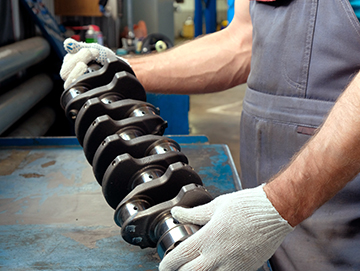Introducing the Crankshaft: The Heart of the Engine
When you turn the key or press the ignition button in your vehicle, a complex dance of mechanical parts begins, all working in harmony to propel your car forward. Hidden from view is the crankshaft, the unsung hero of your vehicle's engine. The crankshaft is responsible for converting the up-and-down motion of the pistons into the rotational power that drives your wheels. To break it all down, Meineke in Harrisburg on Paxton Street explore the vital role of the crankshaft and how it keeps your car's engine running smoothly.
What is a Crankshaft? The crankshaft is a long, slender, and typically heavy steel or cast-iron component within an engine. You can find it within the engine block, running lengthwise and parallel to the ground. The crankshaft is the backbone of the engine, connecting various moving parts and facilitating the conversion of reciprocating motion to rotational motion.
What does a Crankshaft Do? At the heart of the engine, you'll find the pistons moving up and down within their respective cylinders. As the pistons move, they create linear motion, pushing down on the connecting rods that are attached to them. This linear motion is transformed into rotational motion by the crankshaft. The crankshaft's design is ingeniously simple: it consists of several offset crank throws and journals that resemble a series of circles. These offset throws are strategically placed along the crankshaft to convert the linear motion of the pistons into the circular motion required to turn the wheels.
The Crankshaft Likes to Multi-task. The crankshaft's primary function is to convert linear motion into rotational motion, but it serves several other essential purposes as well:
- Counterbalancing: The crankshaft has counterweights, which help offset the vibrations caused by the rapid reciprocating motion of the pistons. This counterbalancing ensures the engine runs smoothly and reduces vibrations that could harm the vehicle or its passengers.
- Power Generation: The rotational motion generated by the crankshaft is what ultimately powers your vehicle's wheels. It transfers this power through the transmission to make your car move.
- Accessory Drive: In addition to driving the wheels, the crankshaft is also connected to various engine accessories such as the alternator, power steering pump, and air conditioning compressor. These accessories are essential for the vehicle's electrical system and driving comfort.
Maintenance and Care and How Meineke can Help
While crankshafts are durable, they are not immune to wear and tear. Regular maintenance and oil changes are crucial to ensure the smooth operation of the crankshaft and other engine components. Neglecting maintenance can lead to damage, and even the replacement of a crankshaft can be a costly and complex repair.
Check out The How a Car Works site's blog on the basics on how an engine works to learn more. Understanding the essential role of the crankshaft in your vehicle's engine highlights the incredible engineering and precision that goes into making your car run smoothly. So, the next time you start your engine, take a moment to appreciate the hidden hero, the crankshaft, that keeps your vehicle in motion.
Meineke in Harrisburg on Paxton Street is here to help with your crankshaft, engine and all your car care needs. If the Harrisburg location is inconvenient, you can get the same top-quality service at any of the other 12 Meineke Car Care Centers in South Central Pennsylvania.
MEINEKE CAR CARE | LOCAL CAR CARE | LOCAL MECHANIC | HARRISBURG CAR CARE | HARRISBURG AUTO CARE | CAR CARE NEAR ME | OIL CHANGE NEAR ME | ASE CERTIFIED | EV CARE | EV BATTERY
#MEINEKECARCARE #LOCALCARCARE #HarrisburgCarCare #HarrisburgAUTOCARE #CarCareNearMe #MeinekeCares #Meineke #OilChangeNearMe #OilChange #ASEcertified #Diagnositics #EV #EVbattery #UsedCarRepair #Engine


